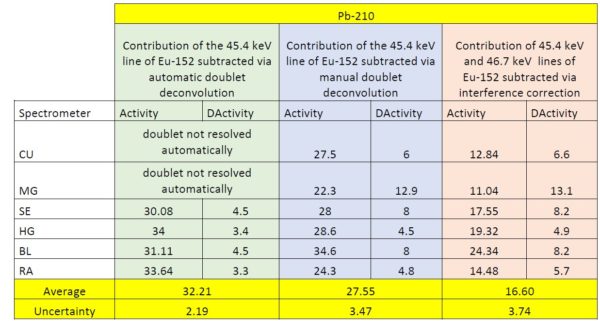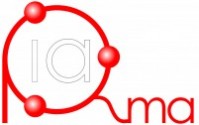After the conclusion of the IARMA ERAD-PT-2022 Proficiency Test, a valuable feedback was received from a participant regarding a common challenge faced by multiple participants when attempting to determine Pb-210 in the presence of Eu-152 in the IARMA-137 Mushroom Test Item. This feedback shed light on an issue that hindered accurate measurements and called for further investigation. In this post, we dip into the difficulties of this challenge, explore the complexities associated with the interference of Eu-152, and present the analytical approaches taken to overcome this obstacle. By sharing these insights, we aim to enhance the understanding of Pb-210 analysis in the presence of Eu-152, offering valuable guidance for future assessments in similar scenarios.
The determination of the massic activity of Pb-210 in the mushroom sample IARMA-137 presented challenges due to the significant activity of Eu-152, which was also present in the sample.
Specifically, there were two energy lines of Eu-152 that were close to the 46.5 keV energy line of Pb-210. These energy lines corresponded to the X-ray lines of Sm-152, which is the daughter product of Eu-152. The X-ray lines, Kβ1 and Kβ2, had energies of 45.4 keV and 46.7 keV, respectively. If the spectrometer had good enough resolution, the Kβ1 line could be subtracted through proper deconvolution of the doublet at 45.4 keV and 46.5 keV. However, the Kβ2 line of Eu-152 at 46.7 keV completely overlapped with the gamma line of Pb-210 at 46.5 keV. Therefore, it was necessary to correct the calculated activity of Pb-210 for the interference caused by Eu-152 at 46.7 keV, which was not done in the automatic analysis procedure.
Multiple measurements were conducted using various spectrometers. The second column of Table 1 presents the individual results for the massic activity of Pb-210 obtained through automatic analysis and deconvolution of the doublet at 45.4 keV and 46.5 keV. The average value and combined uncertainty are also reported in the green set of data as shown in the Table below.

Table 1: The individual results for the massic activity of Pb-210
Upon receiving the evaluation report from IARMA, it became evident for the participant that the result for Pb-210 was not acceptable, with a relative bias of 78.9% and a Z-test of 7.9.
To address this discrepancy, further analyses were performed. Initially, the doublet at 45.4 keV and 46.5 keV was manually resolved to verify the results of the automatic analysis and the reported values. The manually obtained results, shown in the third column of Table 1 (violet set of data), were slightly lower but still consistent with the reported value within the uncertainty. However, in this analysis, the contribution of the Kβ2 line was not subtracted from the line at 46.5 keV.
In the second attempt, the contribution of Eu-152 at 46.7 keV was subtracted from the remaining Pb-210 area at 46.5 keV. This interference was not corrected during the automatic analysis procedure.
The final results, presented in the fourth column (orange set of data), confirmed that the calculated values for the massic activity of Pb-210 were systematically too high due to the incomplete resolution of the interference between Pb-210 and Eu-152 at the energy lines of 46.5 keV and 46.7 keV, respectively. It is worth mentioning that coincidence summing corrections for the 46.7 keV line of Eu-152 were separately calculated using the EFFTRAN efficiency transfer program.
The final corrected result for Pb-210 was determined to be (16.60 ± 3.74) Bq/kg, which agreed with the reference value (18.0 ± 0.54) Bq/kg, with a relative bias of -7.8% and a ζ-test of 0.37.
Based on this analysis, it can be concluded that when the massic activity of Eu-152 is comparable to or greater than the massic activity of Pb-210, evaluating the specific activity of Pb-210 solely from the line at 46.5 keV is challenging, as the contribution of the Kβ2 line of Sm-152 is not negligible and must be taken into account.
If you have experienced similar challenges or have feedback to share regarding the determination of Pb-210 in the presence of Eu-152 in the IARMA-137 Mushroom Test Item, we would appreciate your contact. Your insights are valuable, and together we can enhance our understanding of this complex issue. Please reach out to us with your feedback.

